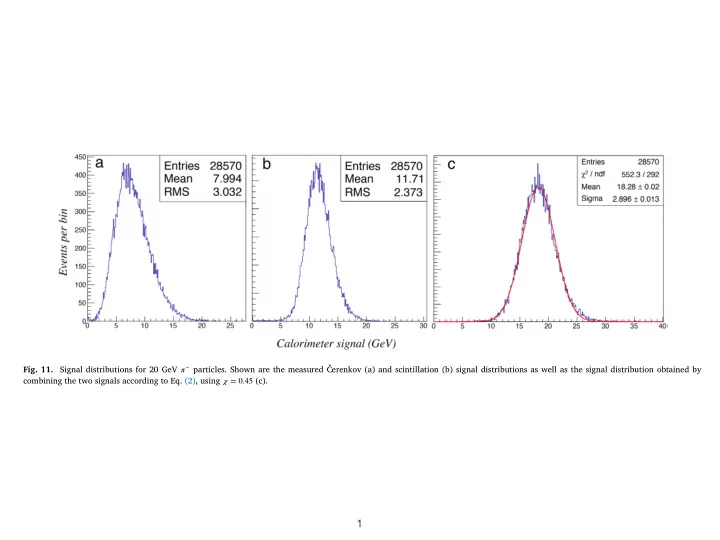

Fig. 11. Signal distributions for 20 GeV ⇡ * particles. Shown are the measured É erenkov (a) and scintillation (b) signal distributions as well as the signal distribution obtained by combining the two signals according to Eq. (2), using � = 0 . 45 (c). 1
On the limits of the hadronic energy resolution of calorimeters Sehwook Lee Kyungpook National University AFAD 2018, Daejeon, January 29 2018 2
Fluctuations of Hadron Showers 500 GeV Pions, Cu absorber Red: e - , e + Cyon: Other Charged Particles 3
The Physics of Hadron Shower Development Large, non-Gaussian fluctuations of EM component Large, non-Gaussian fluctuations of invisible energy losses Responsible for the Fluctuations of Hadron Showers 4
The Calorimeter Response The calorimeter response to the two components are di ff erent. The e/h ratio quantifies the degree of the calorimeter response di ff erence between two components. For example, e/h=2 meant 50% of the non-em component is invisible. 5
Fluctuations of electromagnetic shower fraction NIM A316(1992) 184 QFCAL SPACAL SPACAL The em shower fraction (f em ) depends on Large, non-Gaussian fluctuations in f em the energy of pion and the type of absorber material 6
The hadronic performance of non-compensating calorimeter (e/h ≠ 1) Deviation from 1/ √ E scaling Non-linear response to hadrons in hadronic energy resolution CMS Calorimeter ATLAS Calorimeter 7
The Poor Performance of Hadron Calorimeter Nuclear binding energy losses (root cause) 8
Methods to remedy the poor hadronic performance 1. Compensation - the total kinetic energy of neutrons 2. Dual-Readout - the electromagnetic shower fraction These are measurable quantities that are correlated to the binding energy losses 9
Compensation Boosting the signal contributed by the MeV-type neutrons by means of adjusting the sampling fraction achieves e/h=1 10
Hadronic signal distributions measured with SPACAL (Pb-Scintillation fiber) (Compensating Calorimeter) 11
Dual-Readout Calorimetry • Dual-readout method (DREAM) - The electromagnetic shower fraction is measured by means of comparing scintillation (dE/dx) and Cerenkov signals event by event. The fluctuations in f em can be eliminated. • e/h=1 can be achieved without the limitations such as the small sampling fraction, a large detector volume and a long signal integration time. 12
Dual-Readout Method 13
Hadronic Performance of a Dual-Readout Fiber Calorimeter 14
Comparison of Dual-Readout and Compensation 15
Prediction of the ultimate hadronic energy resolution • GEANT 4.10.3-patch2 • FTFP_BERT physics list • Very large absorber to contain the entire hadron shower • 10, 20, 50, 100 GeV π - sent to Cu and Pb (10,000 events) • Obtained information in each event: - The em shower fraction - The total nuclear binding energy loss - The total kinetic energy of the neutrons 16
Correlation between binding energy loss and f em (a) and kinetic energy of neutrons(b) 17
Correlation between binding energy loss and f em (a) and kinetic energy of neutrons(b) 18
Energy dependence 19
Limit on the ultimate hadronic energy resolution 20
Conclusion • Dual-readout and compensation approaches remedy the poor hadronic performance caused by fluctuations of the invisible energy losses • The good energy resolution, signal linearity, Gaussian response functions and the same calorimeter response to electrons, pions and protons are the characteristic of these two methods in the hadron calorimetry • Dual-readout is better than compensation • The hadronic energy resolution 20%/ √ E can be achieved • Nucl. Instr. and Meth. in Phys. Res. A 882 (2018) 148 21
Backup 22
23
Fig. 11. Signal distributions for 20 GeV ⇡ * particles. Shown are the measured É erenkov (a) and scintillation (b) signal distributions as well as the signal distribution obtained by combining the two signals according to Eq. (2), using � = 0 . 45 (c). 24
Recommend
More recommend